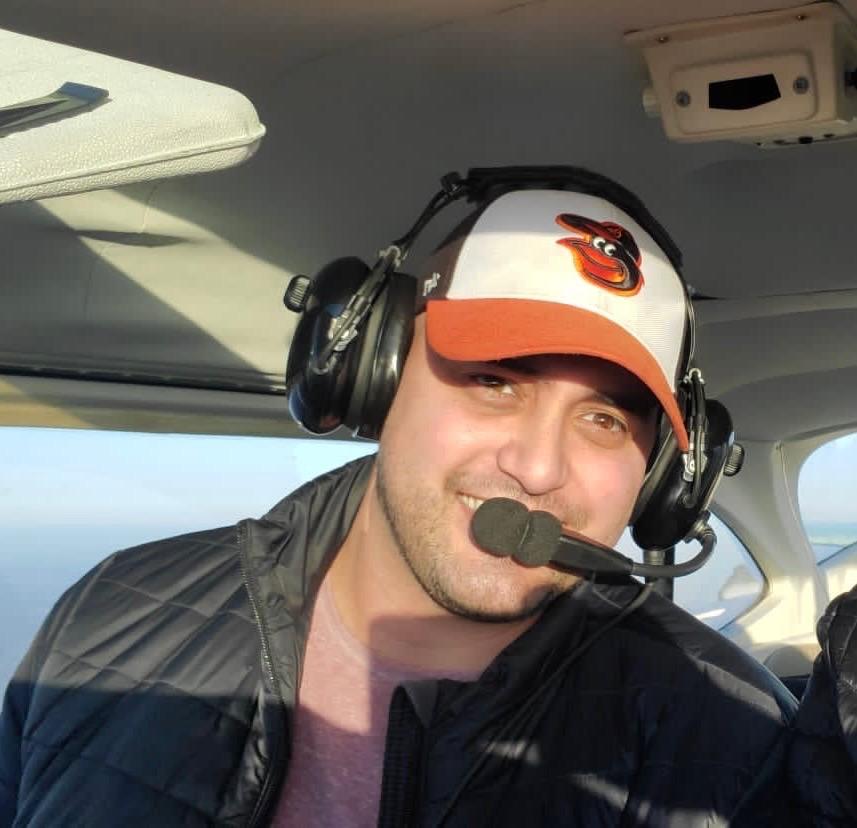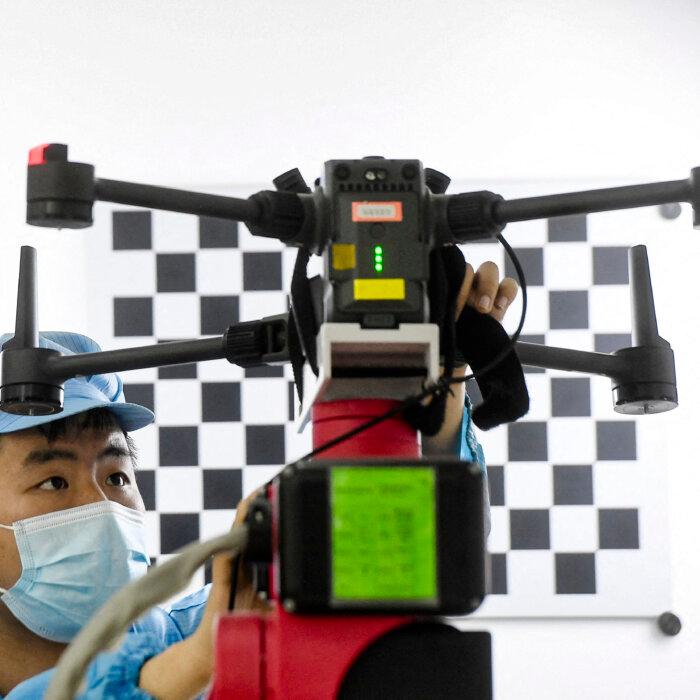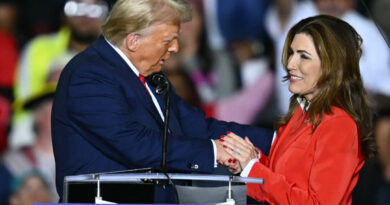Americans Still Uncertain About the Origins of Mysterious Drones
For the last ten years, Jennifer Krazinski felt secure in her home “secluded, away from a dirt road” in Hewitt, a suburb in northern New Jersey.
However, a recent sighting in the night sky left her feeling unsettled.
Krazinski observed objects in the air, exhibiting blinking red and white lights and a whirring noise, close to her residence.
After spotting them for three nights in a row in mid-December 2024, she stated, “I stopped watching for them because it was just too much to handle. This makes me feel anxious,” in an interview with The Epoch Times.
She feared that someone might be utilizing drones for illicit purposes but chose not to inform the authorities, who were already overwhelmed with similar drone-related sightings.
Weeks passed, and Krazinski still sought answers, like many other Americans who witnessed Unidentified Anomalous Phenomena (UAP).
Reports originated from at least six U.S. states since mid-November 2024, generating widespread concern.
While government officials and drone specialists offered benign explanations for the majority of reported sightings, the excitement surrounding the “mystery drones” subsided. Still, questions remain.
The increased public interest in drones has worked to the advantage of U.S. drone manufacturers and retailers.
Industry leaders assert that these incidents highlight a persisting challenge: how to reconcile security requirements and airspace regulations with the push for innovation in drone functionalities and applications.
Experts emphasize that the urgency to refine drone regulations and protocols is intensifying in light of the industry’s rapid expansion.

The Skyfall Vampire drone and SHRIKE FPV drone from Ukraine showcased in the Ukrainian tech pavilion at the Consumer Electronics Show in Las Vegas on January 7, 2025. Patrick T. Fallon/AFP via Getty Images
And drone usage is projected to keep rising.

Allan Evans, CEO of Unusual Machines. Courtesy of Allan Evans
These events have also revealed “a massive deficiency in airspace management,” indicating an urgent necessity to enhance the identification, tracking, and coordination of drone operations, he added.
“People are keen on exploring solutions for this issue rather than merely perceiving drones as toys … merely novelty items,” Evans noted.
There is a growing awareness that “drones are ubiquitous,” he added.
Unusual Machines, which has a strong emphasis on the consumer drone market, witnessed a substantial influx of first-time customers this past year, according to Evans.
While definitive sales data remains unavailable, Evans remarked that the recent drone sightings have indeed triggered new excitement within the industry.
Evans, along with three other industry experts, informed The Epoch Times that both citizens and government officials have valid concerns regarding UAP sightings and drone activities.
Nonetheless, they highlighted the importance of not overreacting or panicking based on misleading, incorrect, or limited information.
These professionals also addressed common inaccuracies regarding drones and proposed ways government agencies could improve their handling of drone-related matters.
About the Sightings

Gabriel Garcia, technical director at SPS Aerial Remote Sensing. Courtesy of Gabriel Garcia
Individuals unfamiliar with the nighttime characteristics of various aircraft might have mistakenly identified manned aircraft as unmanned drones, he explained.
Several aircraft, including drones, have lights that aid in navigation and prevent collisions, and many eyewitnesses reported seeing these lights on unidentified objects.
Garcia believes that authorities possess significant information regarding the drones in question.
This is due to the FAA’s requirement for drones to carry a type of virtual license plate that transmits a locatable signal, Garcia noted.
This signal yields extensive data, including the test coordinates of the drone’s operator, timestamps of movements, altitude, and speed.
Moreover, some aircraft that raised suspicions could have been operated by individuals unaware of regulations or careless in their drone usage, Garcia added.
Concerns were raised by residents wondering why authorities didn’t “just shoot them down” to investigate. However, Garcia asserted that such actions would be hazardous, unwarranted, and illegal without proper authorization.

The Red Cat ARACHNID drone system family: (L–R) Black Widow, FlightWave Edge 130, and FANG displayed in a company photo. Red Cat Holdings
Firstly, there exists a “significant risk” that bystanders could be harmed by stray ammunition or falling debris, Garcia emphasized.
Rather than shooting them down, Garcia suggested that authorities could take over a drone’s control remotely. “They could guide it to a safe landing, resulting in a much safer outcome,” he stated.
Another misconception is that some witnesses claim the drones were as large as buses.
Jeff Thompson, CEO of Red Cat Holdings, a Department of Defense (DoD) drone contractor based in Nevada, stated: “No drone design currently exists that can mimic the flying capability of a small bus. It simply isn’t feasible.”
Thompson elaborated that such erroneous descriptions gained traction simply because “people kept repeating them until it cultivated a common belief, even though it was false.”

Demonstration of technologies designed to detect, track, and identify unauthorized drones crossing the U.S.–Mexico border. Courtesy of SPS Aerial Remote Sensing and TrellisWare
‘Not Enemy Drones’
Many have speculated whether foreign adversaries could be behind the supposed drone swarms as part of espionage missions. However, Thompson dismissed this idea.
“These are not enemy drones,” Thompson asserted. “There’s no conceivable way they could be from an adversary. They would not use FAA lighting … that’s simply preposterous—or they’d be the least clever adversaries imaginable.”
Military reconnaissance drones typically operate without lights, making them undetectable even with night-vision equipment.
“Our drones are designed to be stealthy, and this is a vital trait,” Thompson noted.

Robert Newcomb, a weapons engineer and DOD contractor specializing in drones. Courtesy of Robert Newcomb
Robert Newcomb, a weapons engineer based in Utah and a contractor for the DoD, concurs that many UAP sightings can likely be attributed to people misidentifying manned aircraft or celestial objects like pulsars—rapidly rotating stars.
From his extensive career experience, Newcomb surmises that the reported objects fall within the realm of the expected.
“Typically, if something poses a threat, it reacts swiftly,” he noted. The drones did not appear to cause any harm as they hovered or traversed the sky for extended periods.
Additionally, Newcomb indicated that U.S. agencies possess the ability to detect and respond to threats in their airspace.
“Should we be fearful? Absolutely not,” he stated decisively. “Though there’s an important caveat.”

A still from a video showing several drones appearing to fly over Randolph, N.J., on December 4, 2024. MartyA45_ /TMX via AP
Valid Concerns
Newcomb is apprehensive about the “unknown threats emerging from across the border” in recent years.
“There are likely hundreds of individuals with malicious intent already in the country,” he asserted. “Whether they will utilize drones or other methods remains uncertain.”
Garcia underscored that drones are crossing the U.S.–Mexico border illegally as well. His company has collaborated with U.S. agencies to monitor unauthorized drone activities.
“We’re observing daily activity: Drones breaching the border, operated by cartels for surveillance on border control locations to facilitate human trafficking,” Garcia reported.
Experts indicated that any form of technology can be exploited, noting that it’s natural for people to harbor curiosity about new innovations while simultaneously being cautious about them.
“Do you remember when mobile phones first incorporated cameras? At that time, numerous privacy issues arose,” Evans reflected.
“But it ultimately turned out fine, correct? There’s always going to be resistance to change, and valid concerns will persist.”
Initially, citizens fretted about drone operators spying on them at home.
However, as awareness grows regarding various applications for drones—in law enforcement, healthcare, and package delivery—Evans believes people are beginning to realize that managing drones is “not merely the FAA’s issue.”

Drones are utilized in a demonstration at the Los Angeles Fire Department before DJI’s AirWorks conference in Los Angeles on September 23, 2019. Experts indicate that drones are revolutionizing emergency response efforts, enabling responders to detect fires, monitor toxic gases, or locate missing persons and suspects.Robyn Beck/AFP via Getty Images
He emphasized that the pressing question is “How can various agencies work together?”—from local law enforcement to state agencies to federal authorities.
New drone applications are being discovered routinely, including utilizing drones to deliver flotation devices to drowning victims.
“However, this can only occur if regulations surrounding these operations are established and airspace coordination is effective,” Evans pointed out, noting the potential involvement of helicopters or other aircraft in emergency situations.
“I foresee more groundbreaking applications as we enhance our operational practices.”
Signs of Improvement
It seems policymakers are moving in the right direction—across party lines, Evans noted, referencing several proposals approved or in progress aimed at refining airspace management and bolstering security.
Robbins, president of the Association for Uncrewed Vehicle Systems International, commented on proposed rules regarding drones: “We’re ready to collaborate with the incoming Trump administration to build a stronger, more secure drone technology supply chain.”
Thompson, founder of Unusual Machines, which he now oversees, emphasized that security concerns surrounding the foreign use of drones against the U.S. have escalated considerably.
Many fear that Chinese-manufactured drones might be used for intelligence gathering that would put U.S. security at risk.

Workers manufacturing drones in a factory in Wuhan, Hubei Province, China, on April 13, 2023. STR/AFP via Getty Images
In response to these concerns, the U.S. government took measures starting in 2018 to eliminate the federal government’s use of Chinese drones and components.
The conflict between Ukraine and Russia has underscored the critical role of drones in warfare, with growing apprehension regarding Chinese drones traversing the U.S. landscape and potentially transmitting sensitive data back to servers in China.
Experts Offer Suggestions
The experts concur that the need for streamlined drone regulations remains paramount to facilitate progress.
“The future of our national defense will heavily rely on drones,” Thompson affirmed.
Newcomb expressed concerns that excessive regulations may hinder innovation and technological advancement.
His recommendation is to create designated airspace for drone operations instead of mandating that every drone needs to be tracked.
Evans commended the FAA for its focus on safety, allowing Americans to travel by air with greater safety than by car, as shown by federal data and multiple studies.
Equally, Evans recognizes that the FAA is effectively balancing the necessity for innovation alongside security considerations.

Ukrainian service members of the 22nd Brigade launch a Leleka reconnaissance UAV drone near Chasiv Yar on April 27, 2024. Genya Savilov/AFP via Getty Images
“They are providing numerous exceptions and conducting trial initiatives. They are facilitating plenty of exploratory projects,” he stated.
Concurrently, the FAA is cautious about eluding a “wild west scenario” that could trigger perilous situations, where things might fall from the sky, Evans remarked.
All four drone specialists stressed the importance of enhanced communication among federal entities.
Garcia mentioned that the FAA “does not have the power to take down a drone,” hence it must seek assistance from other government agencies.
Newcomb noted that officials should respond more directly to public inquiries instead of deflecting them and should acknowledge that security concerns limit disclosure to some aspects.
Both Garcia and Newcomb emphasized the need for greater governmental investments in counter-drone technology.
Nonetheless, the experts agreed that federal agencies appear to be proactively addressing drone-related issues.
“I believe we are making strides towards resolving these challenges,” Newcomb concluded, “to ensure the safety of our airspace.”







